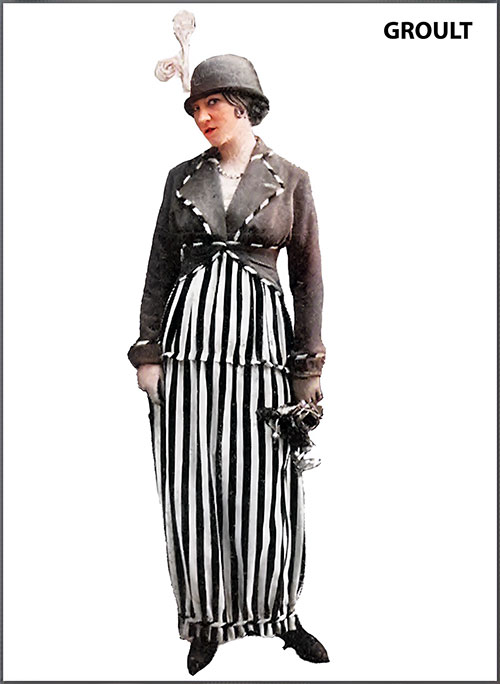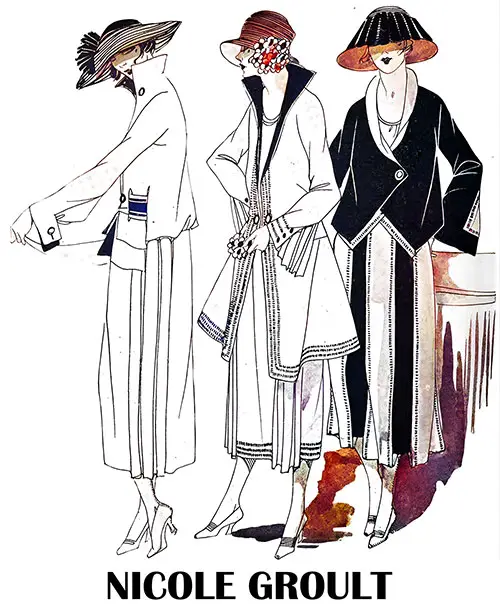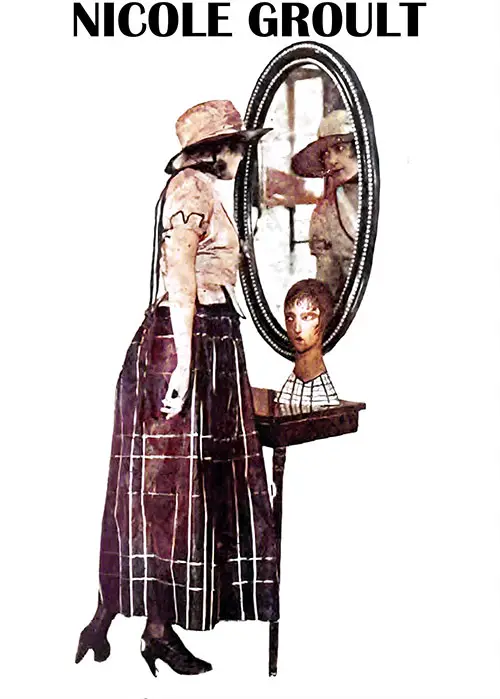Nicole Groult: Parisian Fashion Innovator of Couture & Ocean Travel Elegance (1910s–1920s)

"Les Lauriers," an Evening Gown of Black Silk Muslin Embroidered in Gold Over Black Satin by Nicole Groult. Madame Nicole Groult, the Wife of the Celebrated Decorator, Founded Her House Ten Years Ago and Became Well-Known at Once for Her Original Ideas and Personal Way of Adapting Them to Clothes. She Comes Honestly by Talent as the Sister of Paul Poiret. Garment Manufacturers Index, September 1920, p. 32. | GGA Image ID # 1c8d1014a2
✨ Review & Summary – Nicole Groult
🎀 Introduction & Relevance to Ocean Travel & Fashion
Nicole Groult, sister of the legendary Paul Poiret, carved her own distinctive path in Parisian couture during the early 20th century. Unlike designers who simply followed prevailing styles, Groult reinterpreted them with originality, creating garments that combined modern simplicity with historical inspiration.
Her designs are especially relevant to ocean travel culture:
- Tailored suits in duvetyn and fur, perfect for deck promenades.
- Chic evening gowns embroidered in gold, ideal for shipboard dinners.
- Lightweight fabrics and subdued palettes (powder blue, beige, black and white plaids), practical for packing while retaining elegance.
For teachers and students, Groult’s work illustrates the intersection of fashion, identity, and travel.
For genealogists and historians, her pieces reveal cultural shifts in how women dressed for voyages, leisure, and cosmopolitan life.
The slavish following of style is no part of the philosophy of Nicole Groult, hence an unusual way of interpreting them.
The general impression here is of extremely youthful dégagés silhouettes—little or no drapery, the straight line everywhere; light but not loud colors, chamois, beige, and powder blue.

A Novel Combination of Plain and Striped Materials From Madame Groult. Harper's Bazar, May 1914, p. 50. GGA Image ID # 1cc1f17fb0
A chic hat made on the premises accompanies each tailored gown or suit. Plain tight skirts, short, straight jackets of duvetyn, and velvet trimmed with bands and pockets of fur are characteristic of the tailor-made. Moleskin will be a great favorite, I am told, and also caracul.
Afternoon frocks have round necks and are practically sleeveless or even entirely so. In the case of an elegant black panne velvet model, the hem slightly gathered under a band of chinchilla, faintly embroidered in bouquets strewn here and there, giving a subdued note of color. A broad sash worn well over the hips finishes off a most modern silhouette.
For the evening, I saw very little brocade. Still, a great deal of metal and silk embroidery, designed by the house, and much lace traced over and heavily worked.
While the low décolleté is popular here, it is not universal. An eminently wearable and dainty dinner gown giving a good idea of Groult's talents is shown on this page.

Tailored Suits from Nicole Groult. (l) Tailleur of White Etamine de Laine, the Skirt Box Pleat Ed at the Sides. The Coat Is Boléro, With a Loose Back Shir Red Into a Belt Pass Ing Under the Front Panels. (c) Tailor-Made of Griline Soutachée, Gray Striped in Black. The Skirt Has Narrow Pleated Detached Panels. The Jacket Has a Gored Basque From the Hips Down. The Sleeve Is Interesting. (r) Suit of Terra-Cot Ta Griline, Combined With Same Material in White Striped in Terra Cotta. The Skirt Has Detached Panels Caught in at the Waist and Hem. The Boléro Jacket Is Very Loose. Garment Manufacturers' Index, April 1921, p. 26. GGA Image ID # 1a4040787f
I was going to write different models and remain one of the fashion dictators. Nicole Groult is one of the most original dressmakers in Paris. She can afford to be, for her personality, guided by extreme good taste, enables her to create the most novel.
We have two different lines here: the straight and the very full. The first gives us the most picturesque combinations of embroidery and stuffs, both of the sorts used a century ago and still preserved among the French peasantry.
Tight-fitting cashmere bodices with basques worn over plain dark skirts; a black and white plaid taffeta skirt with a demure bright blue rep bodice looks like an 1820 woodcut. While the following model looks like a glorified portrait of a Bretonne returning from her village fête.
A soft bright blue twill shirred equally all around has a deep hem and flowing sleeves of black velvet. A band of fine white embroidery, fruit, and flowers joins the velvet to the skirt and is repeated on the corsage.
Expect something unusual for the second type of gown. Imagine faithful copies of Velasquez and Van Dyke, rich satins with glossy highlights, billowing taffetas cut into ruches and frills, "thick silks that stand-alone," reproductions in the minutest details of the Seventeenth and Eighteenth Centuries.

This Model of Nicole Groult Shows an Ample Skirt of Black and White Plaid Taffeta Over Which Is Worn a Light Blue Bodice, the Basques Outlined in Back. Garment Manufacturers' Index, April 1921, p. 26. GGA Image ID # 1a40c87313
Tight gored bodices with rounded necks and tiny short sleeves for afternoon and evening wear are worn with long wide skirts. The back and front of the latter are relatively plain, but the hips are padded out under voluminous pleats and folds.
The most striking model "Amanda," created a pleasurable sensation; of heavy silver grey satin, the bodice bordered in black has a magnificent flower embroidered on the front. The same dress in white taffeta is designed for a young girl.
Voluminous organdie trimmed with ruches and scallops, cut up at the sides and dipping down in the back, taffetas of the Victorian type giving the bell-shaped hemline hob-nob with Louis XV panniers, all of them variations on the same generous skirt line brought up to date, a delightful change from our stereotyped modern line.
🌟 Most Engaging Content
Heritage of Innovation– Groult’s connection to Paul Poiret gives her house unique credibility, yet her originality set her apart. She embraced youthful, dégagé silhouettes with straight lines and light colors.
Historical Revivals– Some gowns drew inspiration from Velasquez and Van Dyke portraits, bringing 17th–18th century artistry into modern couture.
Tailored Practicality– Groult paired every tailored gown with a chic hat, demonstrating her eye for complete ensembles suited for both Parisian streets and shipboard elegance.
The Model “Amanda”– A heavy silver-grey satin gown embroidered with flowers became a signature, embodying Groult’s balance of restraint and creativity.
🖼️ Noteworthy Images
📸 Black Silk Evening Gown (1920)– Gold embroidery over satin, a testament to Groult’s opulent yet wearable eveningwear.
📸 Plain & Striped Materials (1914)– Innovative fabric mixing, showing her eye for pattern contrasts.
📸 Tailored Suits (1921)– Etamine de laine and terra-cotta griline demonstrate Groult’s mastery of tailoring.
📸 Plaid Taffeta & Blue Bodice (1921)– A striking ensemble evoking 1820s folk costume with modern flair.
🧵 Brief Dictionary of Terms for Casual Readers
Dégagé silhouette– A relaxed, youthful style with minimal drapery.
Duvetyn– A soft, short-napped fabric resembling suede, popular in tailored suits and capes.
Caracul– Curly lamb fur, prized for trimming coats and jackets.
Moleskin– A dense cotton or woolen fabric (sometimes also a fur) used in travel attire.
Basque– An extension of the bodice over the hips, often shaped or flared.
Panne velvet– A lustrous velvet fabric with a shiny, pressed finish.
Fichu– A triangular scarf draped over the shoulders, used for modesty and decoration.
Ruches– Decorative frills or gathered strips of fabric used as trim.
🎓 Educational Encouragement
💡 Students: Use Nicole Groult as a case study for essays on women’s fashion, travel culture, or historical revivals in design. Compare her work with Poiret’s to see how family influence shaped but did not define couture identity.
📚 Teachers: Groult’s collections are perfect for cross-disciplinary lessons in fashion history, social studies, and art appreciation. Ask students to:
- Compare a Groult gown to an 1820s portrait.
- Discuss how travel shaped clothing choices for elites.
- Explore the role of women designers in reshaping Parisian couture.
"Nicole Groult" in the Garment Manufacturers' Index, New York: The Allen-Nugent Co. Publishers, Vol. II, No. 2, September 1920: 32.
